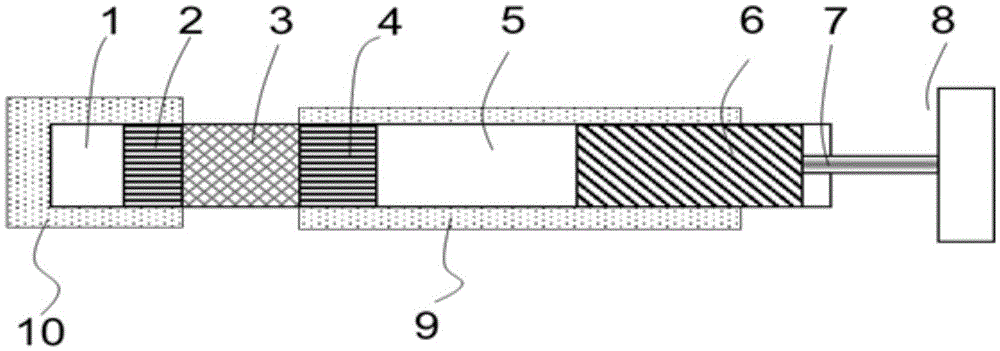Thermo-acoustic engine device
A thermoacoustic engine, sound power technology, applied in the direction of machines/engines, mechanisms that generate mechanical power, mechanical equipment, etc., can solve the problems of sound power transmission and the inability of output power to be directly utilized.
- Summary
- Abstract
- Description
- Claims
- Application Information
AI Technical Summary
Problems solved by technology
Method used
Image
Examples
Embodiment 1
[0031] A standing wave thermoacoustic engine device, its structure is as follows figure 1 As shown, it includes a thermoacoustic engine assembly and a generator 8. The thermoacoustic engine assembly includes a hot-end gas storage 1, a hot-end heat exchanger 2, a regenerator 3, a cold-end heat exchanger 4, and a resonance tube 5 connected in sequence. The resonance tube 5 is also sequentially connected to the acoustic output assembly 12 and the generator assembly, the acoustic output assembly 12 is a vessel, the generator assembly includes a piston 6, a connecting rod 7 and a generator 8 connected in sequence, and the piston 6 is also connected to the vessel, Both the cold-end heat exchanger 4 and the resonance tube 5 are placed in the low-temperature cold source 9 , and the hot-end gas storage 1 and the hot-end heat exchanger 2 are both placed in the high-temperature heat source 10 .
[0032] The sound work generated by the thermoacoustic engine device is transmitted from the ...
Embodiment 2
[0035] A standing wave thermoacoustic engine device, its structure is as follows figure 2 As shown, compared with Embodiment 1, most of the structures are the same, except that the sound power output assembly 12 in this embodiment is the piston 6 of the generator assembly, but compared with Embodiment 1, the length of the piston 6 is longer. The top of the piston 6 in this embodiment extends into the low-temperature environment, and the bottom is connected with the sound power utilization assembly 8. The temperature gradient from temperature to room temperature enables the generator 8 to work normally. Piston 6 is preferably made of materials with low thermal conductivity, such as bakelite, fiberglass, etc., and can also be made of stainless steel.
Embodiment 3
[0037] A traveling wave thermoacoustic engine device, its structure is as follows image 3 As shown, it includes a thermoacoustic engine assembly and a generator assembly. The thermoacoustic engine assembly includes a hot-end heat exchanger 2, a regenerator 3, a cold-end heat exchanger 4, and a feedback pipe 11 connected in sequence. The feedback pipe 11 is also connected in sequence The sound power output assembly 12 and the generator assembly, the sound power output assembly 12 is a pulse tube, the generator assembly includes a piston 6, a connecting rod 7 and a generator 8 connected in sequence, the piston 6 is also connected to the pulse tube, and the cold end heat exchanger 4 , Feedback pipe 11 are all placed in the low-temperature cold source 9, and the hot-end gas storage 1 and the hot-end heat exchanger 2 are all placed in the high-temperature heat source 10.
PUM
 Login to View More
Login to View More Abstract
Description
Claims
Application Information
 Login to View More
Login to View More - R&D
- Intellectual Property
- Life Sciences
- Materials
- Tech Scout
- Unparalleled Data Quality
- Higher Quality Content
- 60% Fewer Hallucinations
Browse by: Latest US Patents, China's latest patents, Technical Efficacy Thesaurus, Application Domain, Technology Topic, Popular Technical Reports.
© 2025 PatSnap. All rights reserved.Legal|Privacy policy|Modern Slavery Act Transparency Statement|Sitemap|About US| Contact US: help@patsnap.com



